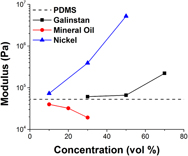Crossref Citations
This article has been cited by the following publications. This list is generated based on data provided by
Crossref.
Markvicka, Eric J.
Tutika, Ravi
Bartlett, Michael D.
and
Majidi, Carmel
2019.
Soft Electronic Skin for Multi‐Site Damage Detection and Localization.
Advanced Functional Materials,
Vol. 29,
Issue. 29,
Koh, Amanda
Hwang, Wonseok
Y. Zavalij, Peter
Chun, Seth
Slipher, Geoffrey
and
Mrozek, Randy
2019.
Solidification and melting phase change behavior of eutectic gallium-indium-tin.
Materialia,
Vol. 8,
Issue. ,
p.
100512.
Wang, Lei
and
Liu, Jing
2019.
Advances in the Development of Liquid Metal-Based Printed Electronic Inks.
Frontiers in Materials,
Vol. 6,
Issue. ,
Ye, Qikai
Wu, Yongzhi
Qi, Yuanyuan
Shi, Lin
Huang, Shuyi
Zhang, Liang
Li, Menglu
Li, Wei
Zeng, Xiangyu
Wo, Hualei
Wang, Xiaozhi
Dong, Shurong
Ramakrishna, Seeram
and
Luo, Jikui
2019.
Effects of liquid metal particles on performance of triboelectric nanogenerator with electrospun polyacrylonitrile fiber films.
Nano Energy,
Vol. 61,
Issue. ,
p.
381.
Zhu, Lifei
Chen, Yuzhen
Shang, Wenhui
Handschuh-Wang, Stephan
Zhou, Xiaohu
Gan, Tiansheng
Wu, Qixing
Liu, Yizhen
and
Zhou, Xuechang
2019.
Anisotropic liquid metal–elastomer composites.
Journal of Materials Chemistry C,
Vol. 7,
Issue. 33,
p.
10166.
Tutika, Ravi
Kmiec, Steven
Haque, A. B. M. Tahidul
Martin, Steve W.
and
Bartlett, Michael D.
2019.
Liquid Metal–Elastomer Soft Composites with Independently Controllable and Highly Tunable Droplet Size and Volume Loading.
ACS Applied Materials & Interfaces,
Vol. 11,
Issue. 19,
p.
17873.
Pan, Chengfeng
Markvicka, Eric J.
Malakooti, Mohammad H.
Yan, Jiajun
Hu, Leiming
Matyjaszewski, Krzysztof
and
Majidi, Carmel
2019.
A Liquid‐Metal–Elastomer Nanocomposite for Stretchable Dielectric Materials.
Advanced Materials,
Vol. 31,
Issue. 23,
Malakooti, Mohammad H.
Kazem, Navid
Yan, Jiajun
Pan, Chengfeng
Markvicka, Eric J.
Matyjaszewski, Krzysztof
and
Majidi, Carmel
2019.
Liquid Metal Supercooling for Low‐Temperature Thermoelectric Wearables.
Advanced Functional Materials,
Vol. 29,
Issue. 45,
Haque, A. B. M. Tahidul
Tutika, Ravi
Byrum, Rachael L.
and
Bartlett, Michael D.
2020.
Programmable Liquid Metal Microstructures for Multifunctional Soft Thermal Composites.
Advanced Functional Materials,
Vol. 30,
Issue. 25,
Su, Yaotian
Sui, Gang
Lan, Jinle
and
Yang, Xiaoping
2020.
A highly stretchable dielectric elastomer based on core–shell structured soft polymer-coated liquid-metal nanofillers.
Chemical Communications,
Vol. 56,
Issue. 78,
p.
11625.
Nosouhi Dehnavi, Fayyaz
Safdari, Masoud
Abrinia, Karen
Sheidaei, Azadeh
and
Baniassadi, Majid
2020.
Numerical study of the conductive liquid metal elastomeric composites.
Materials Today Communications,
Vol. 23,
Issue. ,
p.
100878.
Lin, Yiliang
Genzer, Jan
and
Dickey, Michael D.
2020.
Attributes, Fabrication, and Applications of Gallium‐Based Liquid Metal Particles.
Advanced Science,
Vol. 7,
Issue. 12,
Horne, Jesse
McLoughlin, Lauren
Bury, Elizabeth
Koh, Amanda S.
and
Wujcik, Evan K.
2020.
Interfacial Phenomena of Advanced Composite Materials toward Wearable Platforms for Biological and Environmental Monitoring Sensors, Armor, and Soft Robotics.
Advanced Materials Interfaces,
Vol. 7,
Issue. 4,
Zhou, Tianyu
Guo, Baohua
and
Xu, Jun
2020.
Highly Filled Glycerol/Graphite Suspensions as Fluidic Soft Sensors and Their Responsive Mechanism to Shear.
Advanced Materials Technologies,
Vol. 5,
Issue. 9,
Saborio, Maricruz G.
Cai, Shengxiang
Tang, Jianbo
Ghasemian, Mohammad B.
Mayyas, Mohannad
Han, Jialuo
Christoe, Michael J.
Peng, Shuhua
Koshy, Pramod
Esrafilzadeh, Dorna
Jalili, Rouhollah
Wang, Chun H.
and
Kalantar‐Zadeh, Kourosh
2020.
Liquid Metal Droplet and Graphene Co‐Fillers for Electrically Conductive Flexible Composites.
Small,
Vol. 16,
Issue. 12,
Bury, Elizabeth
Chun, Seth
and
Koh, Amanda S.
2021.
Recent Advances in Deformable Circuit Components with Liquid Metal.
Advanced Electronic Materials,
Vol. 7,
Issue. 4,
Koh, Amanda
and
Vikas, Vishesh
2021.
Wearable Sensors.
p.
107.
Zadan, Mason
Chiew, Cerwyn
Majidi, Carmel
and
Malakooti, Mohammad H
2021.
Liquid metal architectures for soft and wearable energy harvesting devices.
Multifunctional Materials,
Vol. 4,
Issue. 1,
p.
012001.
Shah, Najam Ul Hassan
Kong, Wilson
Casey, Nathan
Kanetkar, Shreyas
Wang, Robert Y.
and
Rykaczewski, Konrad
2021.
Gallium oxide-stabilized oil in liquid metal emulsions.
Soft Matter,
Vol. 17,
Issue. 36,
p.
8269.
Style, Robert W.
Tutika, Ravi
Kim, Jin Young
and
Bartlett, Michael D.
2021.
Solid–Liquid Composites for Soft Multifunctional Materials.
Advanced Functional Materials,
Vol. 31,
Issue. 1,
